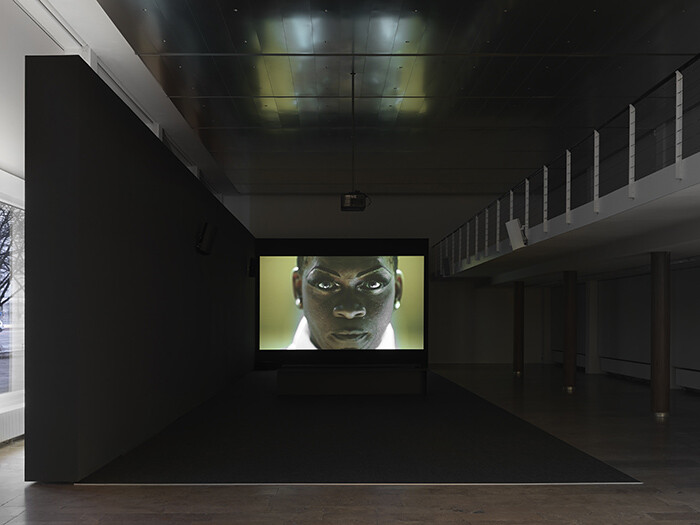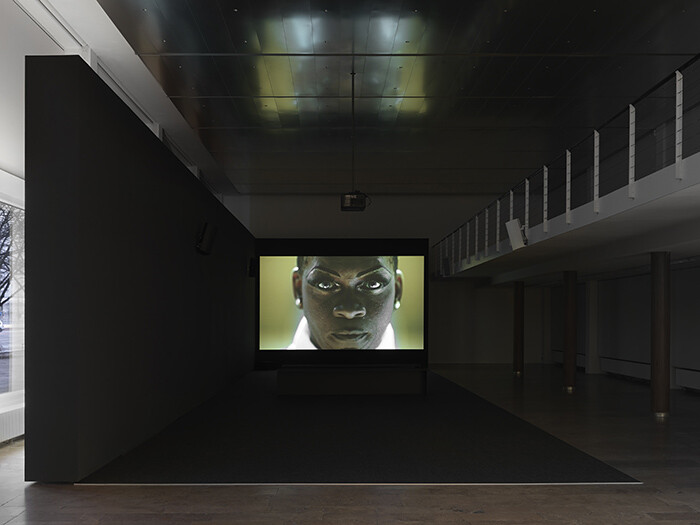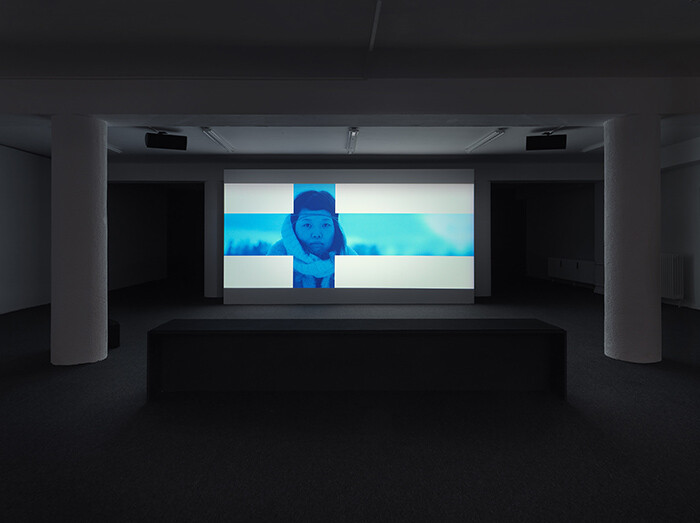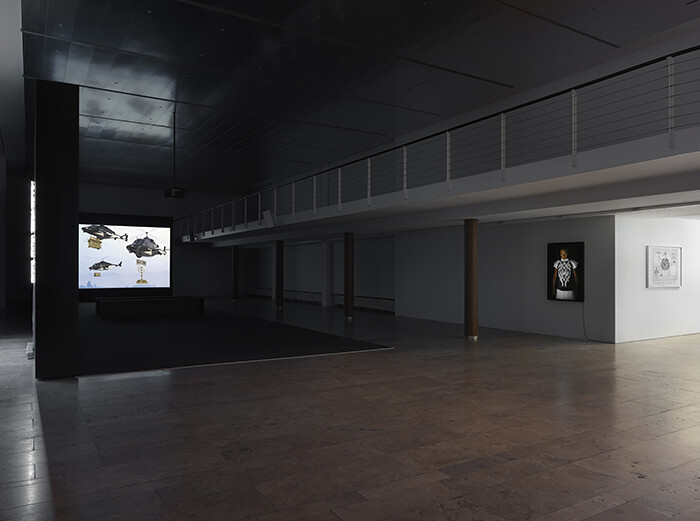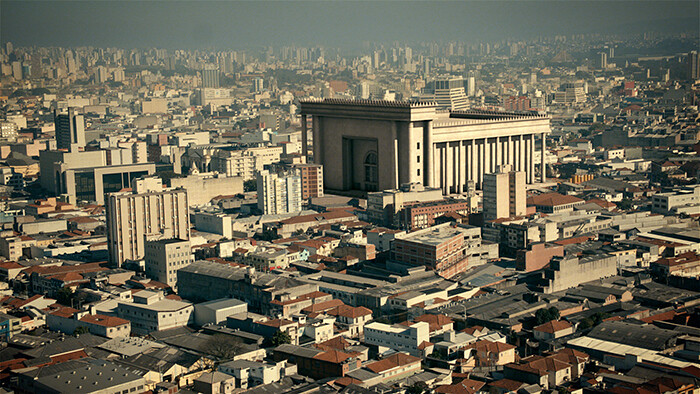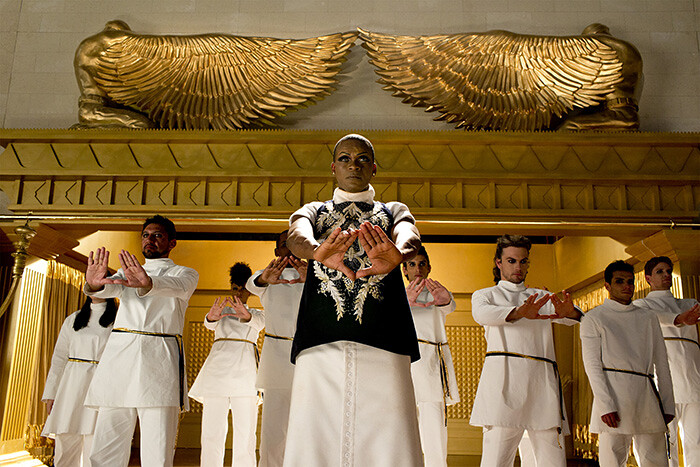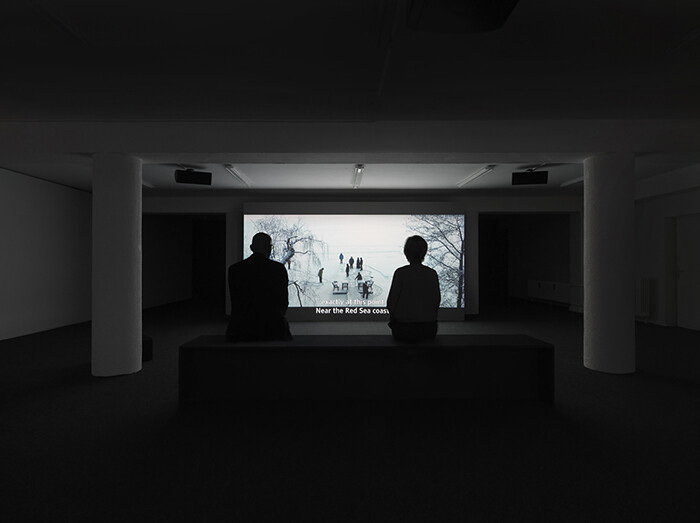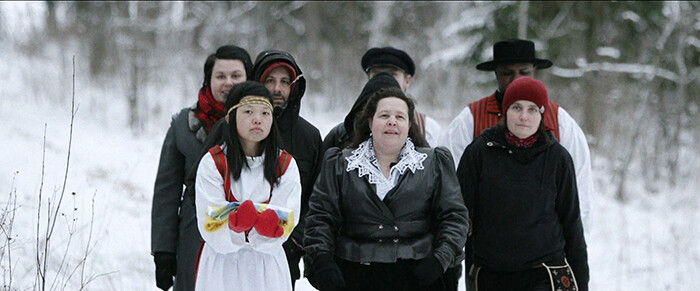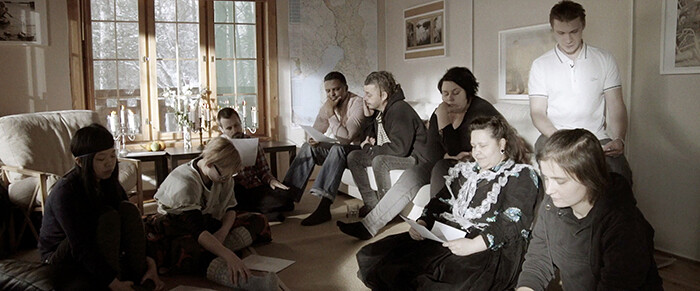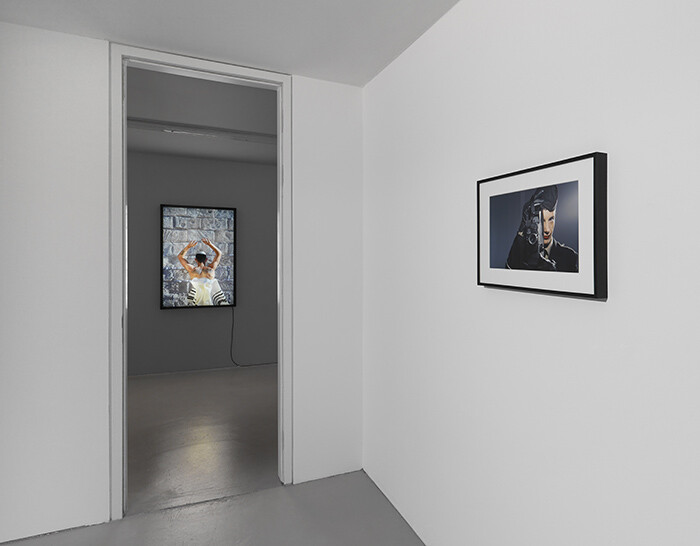Having transformed Capitain Petzel’s glass showroom gallery into a dark, carpeted two-floor Kino, Yael Bartana went on to invert heaven and hell. Inferno (2013), screening on the ground floor, was all fire, brimstone, death and destruction, while True Finn (2014), in the basement below, was a peaceful haven of snowy landscapes and wood-paneled interiors, in which the workings of compromise, tolerance, and freedom of speech were played out. The first film is a mock biblical epic—a “historical pre-enactment” that fuses fact and fiction by staging the destruction of a replica of Solomon’s Temple which, incredibly enough, was recently built in downtown São Paulo by an evangelical Neo-Pentecostal church. In the second film, we follow the progress of eight Finnish participants from different ethnic backgrounds brought to a remote house in the countryside in order to determine which of them is the “True Finn.” Like the Israeli artist’s previous films, these works both traffic in polemic and provocation, but are nonetheless rooted in the political realities of their respective sites. In both, Bartana plays devil’s advocate, zeroing in on the nub of the dilemma—whether adversarial claims on religious history, or on national identity—and taking it to a logical, if extreme, conclusion. In the light of religiously motivated violence across the Middle East, and the recent attacks in Paris and Copenhagen, as well as the concurrent rise of anti-immigration sentiments across Europe, both also strike a depressingly topical chord.
Inferno begins with an aerial survey of São Paulo’s vast urban sprawl then focuses in on one enormous building: the new Solomon’s Temple, 50 meters high and the size of five football fields, built with stones imported from Israel at a cost of several million dollars. The megalomaniacal, not to say absurd, nature of this undertaking informs the tone of Bartana’s film, which features a cast of a hundred dressed in folk costumes with towering headpieces of fruit; shots of helicopters airlifting a gigantic golden Menorah; and a host of special effects from rolling fire balls to fissuring earth surfaces, burning bodies, and collapsing architecture. With a drag-queen priest and the rousing soundtrack of the Jewish hymn Avinu Malkeinu, the bombast is complete. The disaster-movie-style destruction, mirroring the fate of the Temple’s two historical predecessors, is Bartana’s hyperbolic reaction to an already hubristic undertaking, as inferred by a recurring image of melting, Icarus-like wings.
True Finn is astoundingly even-keeled in comparison. This hour-long documentary, whose title refers to the nationalist “Finns Party” (previously known as “True Finns,” and which has gained ground in recent elections), allows each of the individuals (cast by an open call) the opportunity to demonstrate their claim to the title of “True Finn.” After describing their own ethnic backgrounds, they take part in a number of set pieces devised by the artist: composing the lyrics of a national anthem, designing a new flag, and giving election speeches. Differences arise but are abated through discussion (would this have been possible, I wonder, had an actual member of the Finns Party been involved?) When in the end Mustafe, a Somalian, wins the vote, it becomes clear how redundant notions of national identity based on ethnicity are now, after a century defined by migration patterns and social displacement.
In bringing these two tonally different works together, the show not only points to the danger of ignoring historical precedents, whether religious or racially oriented, but also draws attention to the distinct aesthetic vocabulary of Bartana’s work, with its sharp camera work, compelling soundtracks, and penchants for group scenarios, facial close-ups, and traditional costumes. Bartana’s work certainly has its detractors—those put off by watertight direction, seamless editing, high-gloss cinematic style, and the consequent emotional manipulation of its viewers—but her relentlessness in taking an argument to its extreme ensures that her works remain in the productive realm of hypothesis rather than didacticism. The satirical Inferno, in which São Paulo ends up with its very own Western Wall, complete with tourists buying Solomon’s Temple tchotchkes and coconuts inscribed with Menorah, is in the end an experimental proposal. True Finn similarly introduces a number of foreign elements which upset its strictly documentary format and open up an alternative imaginary space. Technicolor clips from 1950s Finnish films demonstrate inherited and mythologized concepts of Finnishness; a huge stuffed bear head appears sporadically on various protagonists, while in many scenes the participants appear dressed in folkloristic costumes, fishing on the frozen lake, or chopping wood. These theatrical inserts suggest a generative, symbolic dimension outside of our contemporary coordinates of time and place, and broaden the debate beyond the specificities of Finland, towards the artist’s own questions of identity, as a non-religious Israeli, now living in Europe, or indeed to those of us all: what does it mean now to be Israeli or Finnish, German or English?
Bartana often talks about “strategies of displacement” in her work, and these devices are used as such to point out an artificiality of approach that allows alternative visions to emerge. “I am trying to define, maybe, a new term for Utopia,” she says. “That conflict is very good, let’s say, conflict is Utopia.”1 The traditional costumes or antiquated activities depicted loosen the hold of contemporary time to suggest a nostalgia for a sense of community and connection to history beyond the limitations of Western individualist societies. Bartana applies her artistic imagination to current issues as if it is a form of activism: to lodge a complaint through action.
In Capitain Petzel, a self-portrait of the artist (Stalag, 2014) looks down from the mezzanine level. An early product from a forthcoming work, it already suggests the direction the next action might take. The artist, dressed in the uniform of female SS guards, stares us down, one eye looking straight at us, the other through the lens of a film camera. Is this a taste of provocation to come?
Yael Bartana and Maria Lind, “Conversation on the IHME Project 2014 True Finn,” in IHME Contemporary Art Festival 2014 (Helsinki: Taidesäätiö Pro Arte Foundation Finland, 2014), 56–73.
